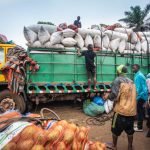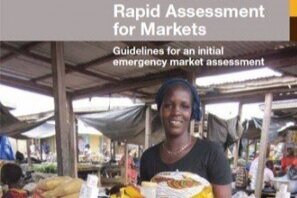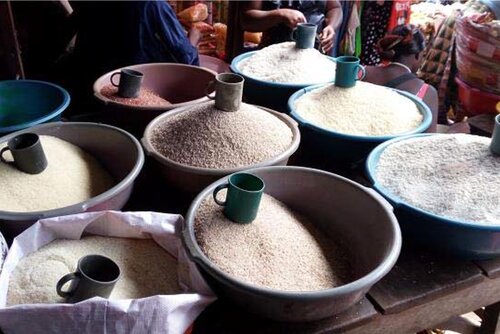
Update: COVID-19 Restrictions, Food Trade, and Recommended Next Steps (June 2020)
January 9, 2024
In Times of Crisis, Leverage Markets to Meet Humanitarian Needs – Rice Case Studies
January 9, 2024Kim Beevers and Loris Shannon-Cooper

In March 2014, Liberia confirmed its first case of the Ebola Virus Disease (EVD) in Foya, Lofa county. In Liberia, 11,000 people were infected with the virus and almost 5,000 people lost their lives by the time the country was declared “Ebola free” for a second time in September 2015.
As part of its efforts to contain the rapid spread of the disease, the Government of Liberia (GoL) and local leaders imposed restrictions on movement, operations, and gatherings[1]. These restrictions were essential in the effort to halt the transmission of EVD.
However, these restrictions also took a toll on the economy, that was further compounded by mining industry under-performance.[2] GDP growth slowed to 0.7 percent in 2014, missing projections estimated at 5.9 percent growth and down overall from 8.7 percent in 2013.
The following outlines significant socio-economic impact that resulted from the EVD response effort. The points offer important reflections for Liberia as the country again addresses a major outbreak – this time COVID-19.
1. Trade across borders, between regions, and at markets was heavily restricted. The Government of Liberia closed borders, reduced and restricted market days, and instigated curfews and checkpoints. This significantly impacted trade.
> Closed borders and closed markets.
Liberia relies on regional trade with its neighbors to source goods and foodstuffs for resale. This is especially the case for markets in Lofa and Nimba that more readily access cross-border trade than they do trade with Monrovia-based businesses.
Borders between Guinea, Sierra Leone, and Liberia were closed in August 2014. Further, Liberia’s state of emergency also introduced restrictions on weekly and daily market operations and trade. As a result, goods that were commonly imported from Guinea or Ivory Coast prior to the outbreak of Ebola, could not be traded. Traders and shopkeepers either stopped selling these goods or adapted to source from Monrovia – at a much higher costs owed to limited product availability and heightened transport costs. The supply of goods declined.
For examples, cassava is Sierra Leone’s largest informally-traded, cross-border good – with significant volumes being traded into Liberia. Further, at the time of the outbreak, about 90 percent of the tomatoes traded in Liberia were actually sourced from the Ivory Coast. Additionally, Liberia informally trades significant cocoa volumes through Sierra Leone; this trade route was largely cutoff during the EVD outbreak.
> High transportation costs.
Transportation was heavily controlled and limited during the Ebola response. Police controlled roadblocks and checkpoints slowed or inhibited the movement of goods. Night-time curfews prohibited truckers from traveling as far in a day as they had previously. And, restrictions on the number of passengers per vehicle or taxi resulted in higher fares and longer waits.
Overall, formal and informal transportation costs skyrocketed. This further challenged trade – in some cases making it unprofitable and/or impossible.
2. Reduced trade hit urban workers and the self-employed hardest – not farmers.
Significant job loss was experienced by urban wage workers and the non-farm self-employed.
- In January 2015, an estimated 9,000 wage workers and 170,000 self-employed workers outside of agriculture were no longer working in Sierra Leone.
- Further, about 41 percent of Liberian household heads who were working in the first half of 2014 reported being out of work in early 2015. Job losses were concentrated in urban settings. Of these, 60 percent were women.
- In April 2015, wage workers reported earning around the same as they did prior to the crisis. However, non-farm self-employed reported 54 percent reduction in revenue. Laborers working in quarantined and non-quarantined districts were impacted similarly.
Amongst this group, women were especially hard hit. In Liberia, women accounted for 60 percent of those household heads that reported being out of work. In Sierra Leone, school and market closures led adolescent girls to spend more time with men, resulting in increased pregnancies and a 16 percent drop in school enrollment post-outbreak.
3. Farmers continued to produce – with little evidence of significant impact on agriculture.
A joint 2015 World Bank-IPA report found lots of evidence that household enterprises in urban settings were hit hard by the EVD response. Conversely, the report found little evidence indicating impact on agriculture.
Farmers continued to produce and trade. However, restrictions on transport and markets did illicit responses amongst farmers – which differed based on commodity:
- With restrictions placed on large gatherings, the traditional labor-sharing system known as kuu was affected. Some labor groups were reduced to 5-10 individuals during the height of the crisis in August 2014 – down from what can be 50 participants.
- Farmers were challenged to move produce to market. Moving agricultural goods from farm to consumers became more difficult, time-consuming and expensive.
- Further, markets were not accessible for a time. Responding to higher costs and reduced market, 20 percent of traders stopped trading in August. This lowered the income of farmers and led to unstable crop prices.
4. Food prices were not impacted nationally.
Overall, food prices followed normal seasonal patterns during the EVD outbreak. Specifically, the price of rice was marginally lower during the outbreak than beforehand (10 percent below 2011 and 5 percent below 2012). The prices of gari and palm oil increased slightly.
Though the outbreak depressed informal activity – such as that of traders, transporters, and market resellers – food prices were not impacted nationally. Price dispersion, on the other hand, was higher than normal. Specifically, in markets that were especially isolated – such as those that experienced significant transport restrictions or cordoning for localized outbreak management – prices spiked. Perhaps counteractively, the prices of imported rice in highly restricted markets decreased.
Some reports suggest that loss of income rather than increased prices of staple foods was the main limitation on households’ ability to purchase food.
Recommendations
Liberia is again faced with similar challenges as it confronts COVID-19. As the country considers its response efforts, we offer two recommendations:
- The above points suggest focal areas likely to be hit hard again – including cross-border and regional trade, informal and household enterprises, and urban areas. Working critically and creatively to design solutions that will lessen the response impact on industries and households concentrated here is recommended. Supporting those hard hit by restrictions may mean focusing on cursory sub-sectors like transport or navigating safe trade and market operations.
- Misleading reports and bad information compounded the EVD challenge and encumbered response efforts. Without reliable data and sound analysis, intelligent and nuanced response efforts are not possible. Investing in quality, frequent research starting right away and continuing is recommended. Evidence should inform policies and response efforts.

GROW Liberia © 2021 All rights reserved



